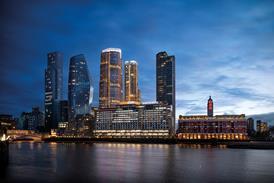It's goodbye prefabrication, golden arches and sticky plastic chairs, hello Jack Vettriano prints and mood lighting. As McDonald's prepares to get serious with a £140m refurbishment and rebranding programme, Katie Puckett met the man overseeing it all
Behind Matthew Midwood looms a picture of a giant tomato. On the walls to his left, there are arty stills of kitchen equipment and in front of him, glass shelves displaying red and green plastic apples. It's his latest project and he hopes it will change the way you think. "It's almost a bit self-indulgent," he admits. "Most people who come here won't necessarily get it."
Whatever people make of Midwood's efforts it can't fail to make an impression - which is exactly what he wants. Midwood is head of construction at McDonald's and he is at the forefront of the burger chain's anxious attempts to lure disaffected customers back into its restaurants. First it served up a healthier menu including salads and low-fat toasted sandwiches, and last month it announced an unprecedented refurbishment programme - over the next three years it will spend £140m on a dramatic transformation of 300 restaurants, doubling the chain's rate of store overhauls. So far, it has completed 24 trial refurbishments.
"A lot of our town centre stores haven't been refurbished for many years because the strategy was all about expansion," says Midwood. "Over the next two to three years, hopefully customers will notice the difference."

McDonald’s’ Bolton branch is part of a “mini-market” of refurbishments in the surrounding area, and is now complete with Jack Vettriano prints, the “Ronald’s Gym Club” area for children, leather-effect sofas and wall diagrams
Credit: Bohdan Cap
The new look is quite a departure, but it needs to be, given the PR blows McDonald's has sustained of late, from attacks on the poor nutritional value of its food to its aggressive marketing to children, all documented in the 2004 film, Super Size Me. Midwood daintily refers to the need to alter "preconceptions".
A lot of our town-centre stores haven’t been refurbished for many years – the strategy was all about expansion
He is also acutely aware of the slump in high-street sales and strengthening competition, both from long-time challengers KFC and Burger King and new threats, such as the ravenously expanding Subway sandwich chain. Last month, McDonald's announced the closure of 25 loss-making stores in the UK, with an overall drop in profits of 14%. Midwood downplays the significance of the closures. "Twenty-five stores when you've got 1250 is not the end of the world. A lot of it is based around turnover of stores or things changing in retail centres." Nevertheless, he must be under a lot of pressure to draw customers back, right? "We're happy to rise to the challenge," is the instant retort.
Although his background is in surveying and on both sides of the contractor-client divide, Midwood admits that these days his job is more about promoting and developing the brand than construction. The branch in which he is sitting, next to Birmingham New Street station, is the flashiest of McDonald's' prototypes, to be deployed in a handful of flagship city centre locations in the UK and on the Continent. Its aspirations are defiantly trendy-wine-bar, with a brown and cream colour scheme, recessed lighting and leather-effect semi-circular sofas in place of sticky plastic booths. In addition to the nutrition-promoting art installations, there are diagrams on the wall detailing McDonald's' supply chain and huge dot matrix screens listing facts about its products. The total bill came to £750,000. "This is a premier brand statement - we're not going to put this in every store," says Midwood. "And it's embryonic - we're testing what fits."
At other revamped branches there are Jack Vettriano prints and a new-style kids area provisionally dubbed "Ronald's Gym Club", with a basketball hoop, dance mat and cycle race computer game. External branding is far more muted. The red is gone, the golden arches give way to a discreet monogram, and cedar cladding has replaced the identikit mansard roofs of its "drive-thru" stores.

Credit: Bohdan Cap
McDonald's' construction department used to be revered for its standardised modular construction - in 2000 it was nominated Client of the Year at the æ´∂´”∞ ” Awards for that very reason. Since the first UK branch opened in Woolwich in 1974 it has devoured sites at a furious rate, peaking at two stores every week between 1999 and 2001, to reach 1251 at the end of last year.
It’s a high concentration of work over a short period of time, so it may make sense to use a larger company, though our existing supply chain has coped admirably so far
However, according to Midwood, it was precisely this formidable production line, with its standardised output, that turned customers off. This year, therefore, McDonald's will open only five new stores. The design team, meanwhile, has commissioned 10 different designs for the refurbishments and Midwood says they will be careful not to repeat them too often.
But McDonald's' existing supply chain is not geared up for such a large-scale change of approach. In 2004, it spent £8m on refurbishment work, rising to £15m last year, mostly carried out by small, family-run contractors under framework agreements. In many cases, McDonald's work makes up the bulk of these contractors' revenues and while Midwood likes the customer service - "It's very hard to get contractors who are focused on what their clients' needs are" - he is less comfortable with their dependency: "I do wince a little bit when I hear that we are 60% or 70% of their turnover," he says. "From any company's point of view, that's not healthy. You don't want them calling up on 1 January and saying ‘what have we got on this year?'"
Undoubtedly, these firms are due for an upheaval as Midwood is recruiting new suppliers to the framework to cope with the increased workload. McDonald's invited submissions of interest earlier this year and sifted 50 or so to make a shortlist of 20. The size of the programme will favour larger applicants, especially as his current strategy will be to blitz "mini-markets", refurbishing all the branches in a locality for maximum impact. "From a contractor point of view it's four to six projects all on site at the same time. It's a high concentration of work over a short period of time, so although our existing supply chain has coped admirably so far it may make sense to use a larger company. We might have a stream for small contractors and a stream for medium contractors."

Credit: Bohdan Cap
Midwood says there will also be greater collaboration between country divisions, particularly France and Germany, so UK firms will find they're competing with Europeans. The new-fangled New Street branch was by a French designer, Philippe Avanci, and some of the furnishings were sourced from Europe. Midwood would also consider using these firms' installation services. "We don't have the blinkers on; we're quite happy to use various procurement routes and if that're outside the UK, then okay."
For now, however, it's all up in the air pending a three-month evaluation of the trial stores. The New Street branch has been open for only two weeks when we meet and Midwood says it's too early to gauge its success, although he hints at "somewhere near double-digit growth" in sales figures. Everything is under review - the interiors, the quieter frontage, the mini-markets strategy and the sort of contractors he'll appoint. Midwood is not afraid to throw his preconceptions on the fire. Nor is he under any illusions about the challenges the company is facing. "It's tough on the high street at the moment. It's a time for the brave. A lot of companies are not reinvesting in stores. We don't put three-quarters-of-a-million pounds into a restaurant lightly. There are a few raised eyebrows in the accounting team when they do the sums, but if you want to generate margins you have to be brave."
Working for Midwood

What are you like to work for?
I’m not a creative thinker; I’m of the more methodical mindset. I’d stop short of saying I’m a control freak, but when you’re managing a project you want to know every piece of the puzzle.
What relationship do you want with contractors?
We want to make sure contractors make a reasonable profit over a sustained period of time. We’re not interested in companies making a fast buck. I’ve dealt with contractors who price low on a competitive tender and make the money back on claims. That sort will work once for us.
What could firms say to win you over?
I listen to what they’ve done, rather than what they’re saying they can do. People who come to pitch tend to have the – how shall I put it – gift of the gab. I take up references from previous clients, not from mistrust, more to check quality and delivery.
What’s your biggest frustration with contractors?
We worked with one supplier for 15 years building drive-thrus but we don’t have a strong relationship with them now because we’re not using them on a regular basis. They dismiss you as a valid client. When I come to consider new ways of procuring work, I’ll be more mindful of the contractors who wanted to know rather than the ones who didn’t because we had no work on at the moment.
McDonald's at a glance
Annual spend: £21m this year rising to £47m in 2007
Workload: 300 stores to be refurbished over next three years. Only five new-builds this year
Who they work with
Contractors: Galamast in Kent, Forrest Contracts in Blackburn, Cathedral Contracts in Lincoln, Conlon Construction in Preston, Mark James Complete æ´∂´”∞ ” Services in Worcestershire
Designers: SHH, Adcock Clayton, IDL
Quantity surveyor: Edmund Shipway
























No comments yet